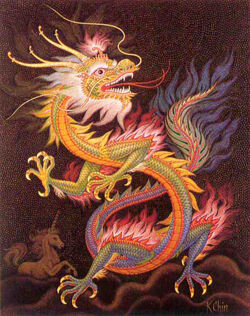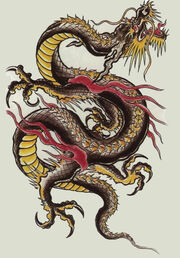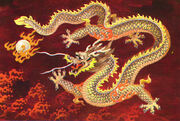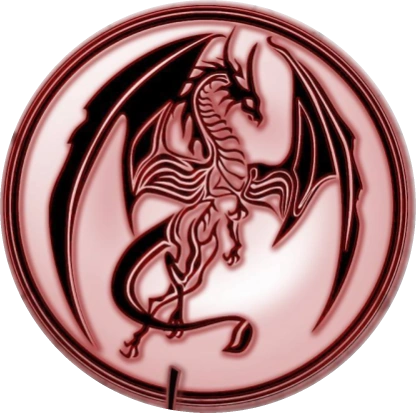No edit summary |
No edit summary |
||
| Line 13: | Line 13: | ||
[[File:Chinese-dragon-red.jpg|thumb|left]] |
[[File:Chinese-dragon-red.jpg|thumb|left]] |
||
| + | |||
===Types=== |
===Types=== |
||
1. Tianlong, the Celestial Dragons, are the celestial dragons who pull the chariots of the gods and guard their palaces. |
1. Tianlong, the Celestial Dragons, are the celestial dragons who pull the chariots of the gods and guard their palaces. |
||
Revision as of 19:13, 3 June 2009

The Oriental Dragon is seen in culture, folklore, religion, and mythology in the East, mainly in Asia.
The Oriental Dragon is another one of the world's most commonly known dragons. They are found in folklore, mythology, and religion all throughout East Asia. These dragons all symbolize different things. Although the European dragons were known to have terrorized people and to have been evil, this was not the case for the Oriental dragons. These dragons were said to been guardians. They were the supposed protectors of heaven. They also guarded the good of the people and royalty to maintain good leadership for the people. They were also said to have been the protectors and controllers of both the Earth's elements and its weather, such as the wind and the rain.
Although the appearances of the Oriental dragons are slightly different throughout East Asia, they are all very similar. Most of these dragon's appearances are based off that of the Chinese dragon. In Chinese folklore and mythology, the Chinese dragon's bodies consisted of parts of several different real-life animals.
The history of the Oriental dragon dates back to and probably even farther back than the Xia Dynasty, the first Chinese Dynasty, in 2100 BC. This was 4109 years ago. The dragon became the symbol of the Emperor. Eventually, it was declared that only the Imperial Dragon of the emperor of China would possess five toes. This was the distinction between the Emperor's dragon and the common dragon seen in folklore.

Physiology
Chinese dragons have serpentine bodies, four legs, and are usually without wings. They are said to be a composite of various other animals-the body of a snake, the antlers of a deer, the talons of an eagle, the soles of a tiger, the scales of a carp, and the eyes of a demon. It is said that Chinese dragons have 117 scales.
They are usually depicted with four toes. In the traditional symbol of the emperor, the dragon is depicted with five. In Japan, dragons are depicted with three toes.

Types
1. Tianlong, the Celestial Dragons, are the celestial dragons who pull the chariots of the gods and guard their palaces. 2. Shenlong, the Spiritual Dragons, control the wind and the rain. 3. Fucanglong, the Dragons of Hidden Treasures, are underworld dragons which guard buried treasures, both natural and man-made. Volcanoes are said to be created when they burst out of the ground to report to heaven. 4. Dilong, the Underground Dragons, are earth dragons whose task it is to preside over rivers and streams. According to some accounts, they are the female counterpart of the Shenlong and they fly only in order to mate. 5. Yinglong, the Winged Dragons, are the oldest of all eastern dragons and the only kind with wings. 6. Qiulong, the Horned Dragons, are considered to be the mightiest dragons. 7. Panlong, the Coiling Dragons, are water dragons believed to mostly inhabit the lakes of the Orient. 8. Huanglong, the Yellow Dragons, once emerged from the River Luo and presented the legendary Emperor Fu Hsi with the elements of writing. They are known for their scholarly knowledge. 9. Lóng Wáng, the Dragon Kings, are rulers over each of the four seas, those of the east, south, west, and north. Although their true form is that of a dragon, they have the ability to shapeshift into human form. They live in crystal palaces guarded by shrimp soldiers and crab generals.
